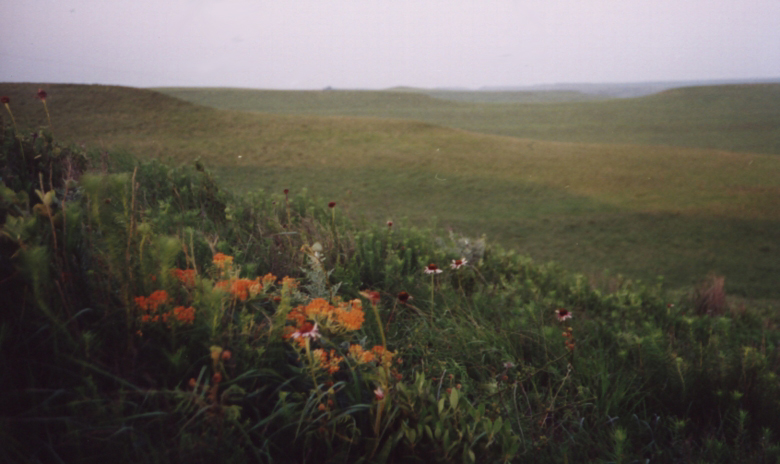
|
Focus Topics: Grasses and Tallgrass Prairie Other Topics: Bison, Prairie Chickens, Common Nighthawks, Elm-Ash-Cottonwood Forest |
|
|
Grasslands are some of the most productive ecosystems on earth, and the tallgrass prairie is one of the most productive types of grasslands.
The Konza Prairie is a remnant of an ecosystem which once extended from Illinois northwest to the Dakotas and south to Texas. It sits on an 8,616-acre preserve near Manhattan, Kansas. While grasses are the dominant plants on the prairie, wildflowers, shrubs and trees add variety and color to the landscape. The dominant grasses on the prairie are Andropogon gerdardii (big bluestem), Sorgashastrum nutans (Indian grass), and Schizachyrium scoparium (little bluestem).
Grasses are flowering plants in the class of monocots (Liliopsida). The subclass to which grasses belong, Commelinidae, also includes palms, spiderworts, bloodworts, water hyacinths, bananas, ginger and others. The order Poales includes grass-like plants such as rushes, sedges and cattails but all true grasses are in the family Poaceae within that order.
Bison used to be found in vast numbers all across the great plains which include the tallgrass prairie. A much smaller number can be found today in certain sections of the Konza Prairie. Within the class of mammals, bison used to be classified in an order called artiodactyla. As of this writing that order no longer exists and bison and other ruminants are found in a group called Cetartiodactyla, which also includes the cetaceans such as whales. The suborder Ruminantia to which bison belong also includes deer, giraffes, pronghorns and chevrotains. The family Bovidae includes the true antelope, gazelles, cows, sheep, goats, duikers and true buffalos (Bison are in a separate genus from true buffalos such as the water buffalo found in Africa).
Konza Prairie: A Tallgrass Natural History, by O. J. Reichman, is a great source book for information on the Konza site and the tallgrass prairie in general. In the discussion of the grassland ecosystem on pages 71 to 76, Reichman points out many of the species that may be found. To help visualize the plants and animals mentioned, see this illustrated companion of the book.
Other examples of the tallgrass prairie ecosystem can be found in Kansas, Iowa, and Oklahoma: The Tallgrass Prairie National Preserve is a recent addition to the National Park System near Cottonwood Falls, Kansas; the Neal Smith National Wildlife Refuge is located near Prairie City, Iowa; and the Nature Conservancy's Tallgrass Prairie Preserve is near Pawhuska, Oklahoma.
|
© 2002 Connected Earth Enterprises
Problems viewing this website? Contact webmaster@connectedearth.net.